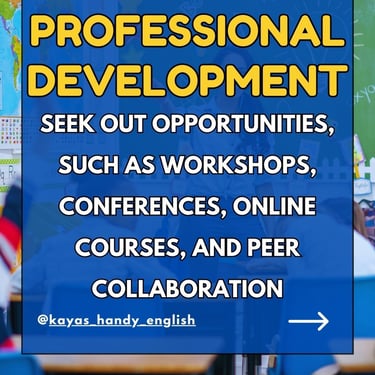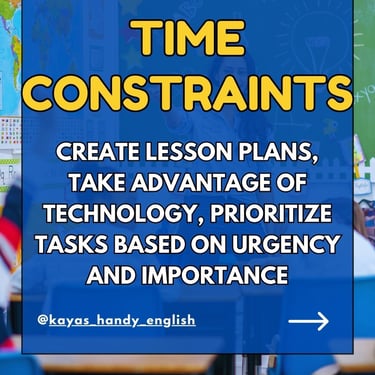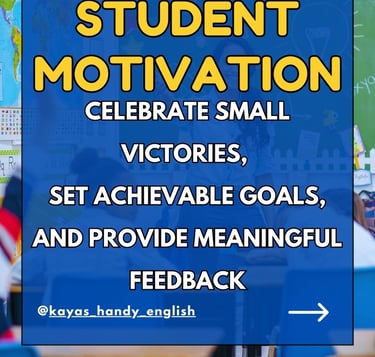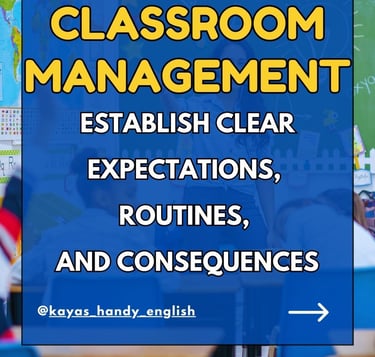[BLOG] Navigating the ESL Teaching Maze
Not sure if teaching English is for you? Read this blog post about overcoming common challenges in ESL and find out!
Kaya
3/1/2024
Please keep in mind that the opinions posted on this blog are my own.
Everybody might have a different experience and opinions, and that's OK.
Navigating the ESL Teaching Maze: Overcoming Common Challenges
Teaching English as a Second Language is an exhilarating adventure filled with moments of triumph and discovery. Yet, like any journey, it comes with its fair share of hurdles. From cultural barriers to classroom management woes, ESL teachers face a myriad of challenges on a daily basis. Fear not, fellow educators! Let's unravel these obstacles and arm ourselves with strategies to overcome them.
Language Barriers: Breaking Down Walls, Building Bridges
One of the most common challenges ESL teachers encounter is navigating language barriers. Whether it's explaining complex grammar rules or facilitating discussions, bridging the gap between languages can be daunting. However, embracing visual aids, gestures, and simplified language can help make concepts more accessible to students. Encouraging peer collaboration and providing ample opportunities for practice can also enhance language acquisition.
Diverse Learning Styles: Embracing Variety in the Classroom
Every student is unique, with their own preferred learning style and pace. Catering to diverse learning styles, from visual learners to kinesthetic learners, can be a daunting task. By incorporating a variety of teaching methods, such as multimedia presentations, group activities, and hands-on experiences, we can engage students more effectively and accommodate different learning preferences. Flexibility is key in creating an inclusive learning environment where every student feels valued and supported.
Classroom Management: Striking the Balance
Maintaining order and discipline in the classroom is a constant challenge for ESL teachers. With students from diverse cultural backgrounds, norms, and behaviors may vary, making classroom management a delicate balancing act. Establishing clear expectations, routines, and consequences from the outset sets the tone for a respectful learning environment. Building positive relationships with students, fostering open communication, and addressing behavioural issues promptly can help mitigate disruptions and create a harmonious atmosphere conducive to learning.
Limited Resources: Making the Most of What You Have
Resource constraints, whether it's a shortage of textbooks, technology, or teaching materials, can hinder effective ESL instruction. However, creativity knows no bounds! Leveraging free online resources, utilizing multimedia platforms, and creating interactive activities from scratch can breathe life into lessons without breaking the bank. Collaborating with colleagues, tapping into community resources, and seeking professional development opportunities can also expand your toolkit and enhance teaching effectiveness.
If you are still short of resources, may I introduce you to my no-prep activities and lesson plans?
Cultural Sensitivity: Navigating Cultural Differences with Grace
In a multicultural classroom, cultural sensitivity is paramount. Misunderstandings, stereotypes, and cultural clashes can arise if not addressed proactively. Taking the time to learn about students' cultural backgrounds, traditions, and communication styles fosters mutual respect and understanding. Incorporating diverse perspectives into the curriculum, promoting open dialogue, and addressing sensitive topics with sensitivity and empathy can create a safe and inclusive learning environment where everyone feels valued and accepted.
Student Motivation: Igniting the Spark
Motivating ESL students, especially those who may be grappling with language barriers or lack of confidence, can be a challenging feat. Recognizing and celebrating small victories, setting achievable goals, and providing meaningful feedback can boost student morale and engagement. Incorporating real-life examples, relevant topics, and interactive activities that resonate with students' interests and aspirations can also reignite their passion for learning English.
Time Constraints: Juggling Multiple Priorities
Time is of the essence in ESL teaching, with countless lessons to plan, assignments to grade, and students to support. Managing time effectively amidst competing priorities requires strategic planning and organization. Creating lesson plans with clear objectives and timelines, leveraging technology to streamline administrative tasks, and prioritizing tasks based on urgency and importance can help maximize productivity and minimize stress.
Luckily, my no-prep activities and lessons come to the rescue!
Assessment and Evaluation: Balancing Rigor and Fairness
Assessing ESL students' progress and proficiency levels presents its own set of challenges. Designing assessments that accurately measure language skills while accommodating diverse learning styles and abilities requires careful consideration. Incorporating a mix of formative and summative assessments, providing timely and constructive feedback, and offering opportunities for self-assessment and reflection empower students to take ownership of their learning journey. Flexibility in assessment methods and grading criteria ensures fairness and equity for all learners.
Parental Involvement: Building Bridges with Families
Providing you teach children, collaborating with parents and caregivers is essential in supporting ESL students' academic success and holistic development. However, language barriers, cultural differences, and busy schedules can hinder effective communication and engagement. Establishing open lines of communication, offering translation services or bilingual materials, and organizing parent workshops or events can bridge the gap between home and school. Valuing parents' insights, concerns, and contributions fosters a sense of partnership and strengthens the support network for ESL students.
Professional Development: Lifelong Learning and Growth
Staying ahead of the latest pedagogical trends, methodologies, and technologies is crucial for ESL teachers' professional growth and effectiveness. However, finding time and resources for professional development can be challenging amidst busy schedules and competing demands. Seeking out professional development opportunities, such as workshops, conferences, online courses, and peer collaboration, enriches teaching practices and keeps educators inspired and motivated. Embracing a growth mindset, seeking feedback, and reflecting on teaching experiences fosters continuous improvement and ensures ESL teachers remain dynamic and resilient in an ever-evolving educational landscape.
Thriving in the ESL Teaching Jungle
While ESL teaching may present its fair share of challenges, armed with creativity, resilience, and a passion for language education, educators can overcome any obstacle that comes their way. By embracing diversity, fostering a positive learning environment, and continually honing their craft through professional development, ESL teachers empower students to unlock their full potential and embark on a transformative language journey.










Get in touch!
Copyright Handy English 2021
”I used this with an adult ELL tutee of mine. I appreciate that the language was accessible for multiple proficiency levels, but the content wasn't obviously geared for children and still useful for older learners.”
August 7, 2023
”Another great resource from Handy English! I used it to give my students more in-depth practise into quantifiers and restaurant language. It's great resource and can be used after the students learn the basics of language for the restaurants and quantifiers. Definitely helped solidify what they learnt.”
February 5, 2023
”Love this resource. Great for fast finishers and also those in small ESL groups. Great for all macro skills as discussion and brainstorming is a great precursor for writing submissions.”
- Gail M.
June 25, 2023
Here's what other ESL Teachers say
Handy English: 4.8/5
”This was a wonderful resource for my students. It helped me introduce them easily to new concepts and it was quite engaging. Thanks!”
- Kiara B.
October 10, 2023
”Great resource for learning vocabulary, which supports comprehension and speaking skills.”
- Lori-Ann W.
September 29, 2023
”What a great way to get a healthy debate going. My students struggle with impulse control and they all have kept it kind and appropriate.”
- Alicia H.
September 17, 2023






